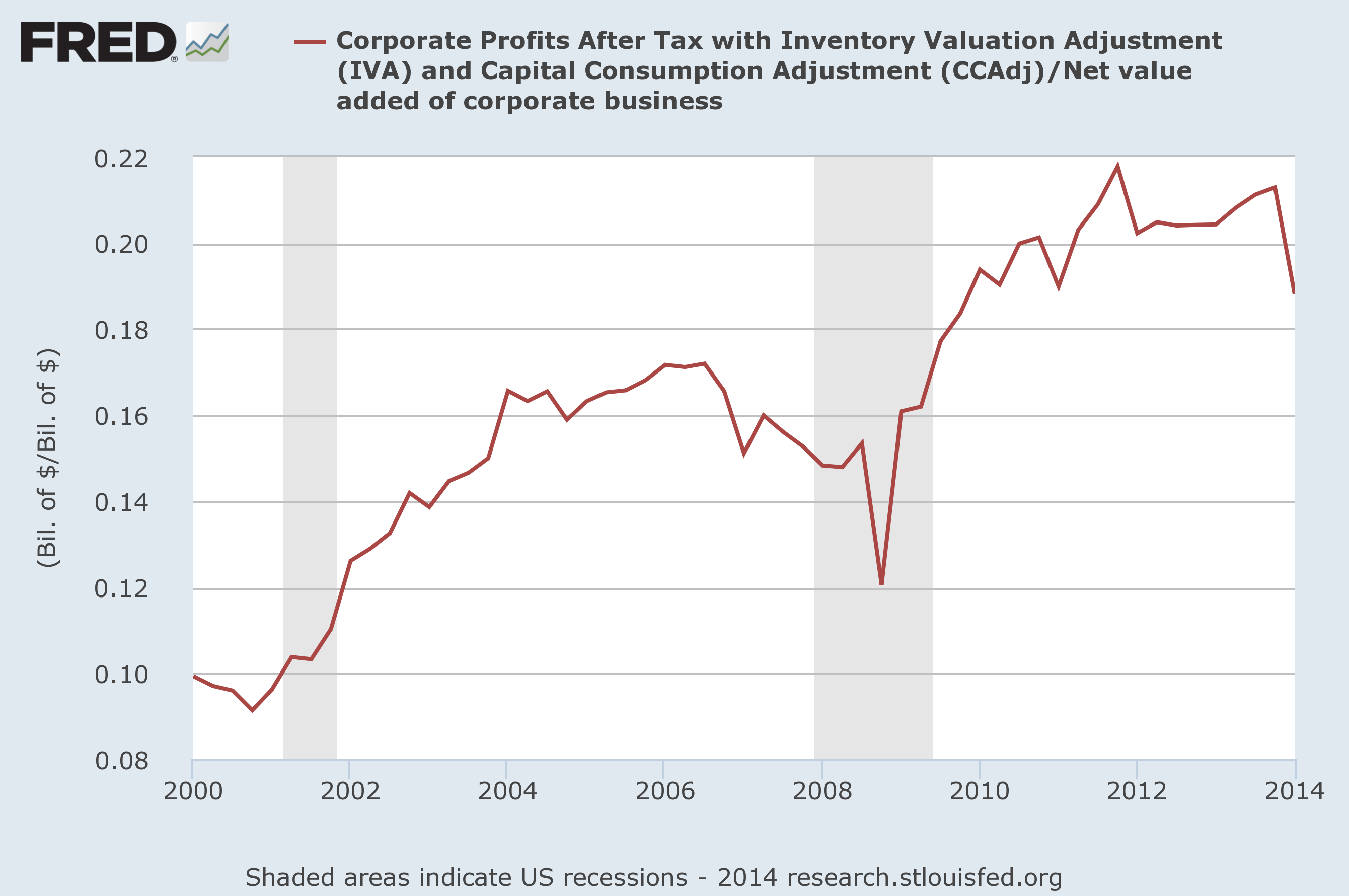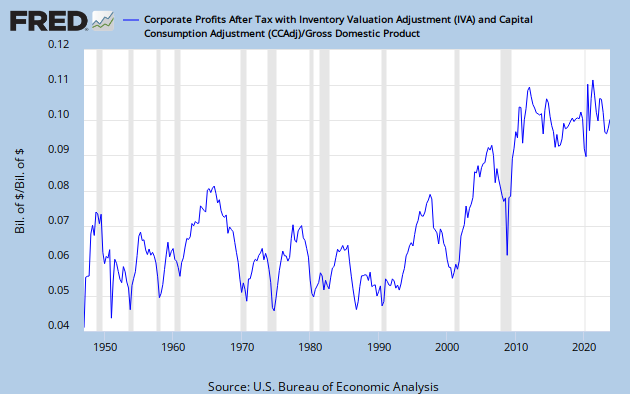Guest Post by David Stockman
The 2008 Wall Street meltdown is long forgotten, having been washed away by a tsunami of central bank liquidity. Indeed, the S&P is up nearly 200% from its March 2009 low. Yet four cardinal measures of Main Street economic health convey nothing like a 2X pick-up from the post-crisis bottom.
To wit, in June the count of breadwinner jobs was 68.5 million or 5% below were it stood as the crisis got underway. Likewise, business investment in real plant and equipment is still 5% below its late 2007 peak. So too with the real median family income at about $53k—its still down by 6%. And unlike past cycles where safety net programs like food stamps shed recipients as the recovery gained momentum, there are still nearly 47 million Americans in the program compared to 30 million in March 2009.
This juxtaposition has been explained away by Wall Street stock touts under the heading that “this time is different”. Markets have allegedly sprung loose from their moorings in the real economy owing to record corporate profits and an upward re-rating of PE multiples reflecting lower than historical interest rates. And, indeed, the raw facts can be marshaled to this end.
As shown in the stunning chart below, profits have doubled as a share of corporate net value added since the turn of the century. Likewise, when measured against GDP, profits are at 60-year highs.
This is just the trouble, however. The robust rate of profit growth during recent years reflects a one-time gain in the profit share of factor income. This gain in all probability cannot be replicated again during the next decade, and, in fact, is extremely vulnerable to the mean reversion so evident in the historical data above. Indeed, that may have already begun during the first quarter of 2014 when the profit share dropped sharply as shown in both charts above.
The same can be said of low interest rates. After an unprecedented 33-year descent, the yield on the treasury benchmark has nowhere to go but higher; and after hitting a QE induced rock bottom of 1.5% in mid-2012, the benchmark yield has, in fact, bottomed and begun a climb toward normalization. No amount of money printing and financial repression by the central banks can keep yields on the massive trove of $12 trillion of publicly-held treasury debt at a negative after-tax and after-inflation rate indefinitely.

Even without any allowance for profit and interest normalization, PE multiples are at the top of their historic range and at a point of extreme vulnerability where market crashes have invariably occurred in the past. In the case of the S&P 500, for example, reported LTM earnings adjusted for a recent pension accounting change which is not reflected in the historical data stand at about $100 per share. This means the broad market of big cap stocks is trading at 19.8X—a tippy-top capitalization rate that has never been sustained.
And that is before considering the impact of interest rate normalization on the $3 trillion of debt carried by the S&P companies. That alone could reduce reported EPS by $5-$8 per share, and also throw a monkey wrench into the debt-financed flurry of stock buybacks that have accounted for nearly all of the gains in per share earnings during recent quarters.
Then there are the numerous and compounding headwinds lurking down the road. These include baby boom demographics and the massive overhang of $60 trillion of public and private debt domestically; and global troubles everywhere—from the bankrupting old age colony in Japan, to the tottering house of cards known as “red capitalism” in China, to the crushing burden of the socialist welfare state in Europe. Given these adversities, there is no reason to assume that US real growth will sharply accelerate from the tepid trends of the recent past.
Yet at current top-of-the range PE multiples, the market has priced in a macro-economy that is expected to attain the kind of “escape velocity” that has been evident in historical business cycles. Unfortunately, we are now in month #61 of this recovery cycle–well past the 55 month historical average for a recovery—and there has been no sign of a conventional cyclical rebound whatsoever. In fact, based on the disastrous Q1 GDP number (which is fixing to be further reduced in the upcoming benchmark revisions) and the tepid trends during Q2, forecasters are now tracking 2014 GDP growth at 1.7%—the lowest rate since the 2009 bottom.
In short, the market is pricing in a future based on past business cycles that are now irrelevant in an economy laboring under $60 trillion of public and private debt and a peak 3.5X leverage ratio against national income. This means that historical credit fueled growth is no longer possible, and that GDP therefore can grow, at best, only at the tepid rate at which real wage and salary incomes are inching forward.
This all adds up to a case for capitalizing corporate earnings at a rate well below the historical norms, not at the tippy-top of prior experience. But the Wall Street casino is so juiced-up on the Fed’s promise of endless liquidity and puts under the stock averages that it is uninterested in the fundamentals, and will keep buying the dips until some confidence shattering black swan comes flying in from out of the blue.
And that points to the real evil of monetary central planning and the serial financial bubbles that it inexorably produces. Bubbles are only recognized after the burst into a flaming crash. The chart below regarding the $2.3 trillion private label market in securitized sub-prime mortgages created by Wall Street in the run up to the last bubble top say it all. What we heralded to be money-good par securities because that time was different have ended up in a smoldering pile of toxic waste.








This time is different, Grandma Yellin and Steve Leesman and Cramer told me so. The market will never go down, the Fed put will always save me. I will buy the fucking dip every chance I get, and will take out maximum margin debt to buy Twitter stock. I will be rich beyond my wildest dreams, forever and ever.
[img [/img]
[/img]
What is truly amazing is that TPTB controlling the financial levers of the world have held it together this long! And, the longer that they keep pumping the planetary economy and assuring the lemmings (love that video) that “ALL IS WELL – BUSINESS AS USUAL” the worse the tumult when it all comes tumbling down.
I have no pity for the sheep and lemmings that WILL NOT see the truth, and cling to the lies as truth.
I have talked to people who know shits just not right. Dumbshits – all of ’em. Because they don’t have to believe and read and learn about all the evidence and proof that abounds……they just need to get snagged on one or two things that just don’t add up That should be enough to get them questioning and learning more about their investments, lives in general, and their children’s futures. But they dismiss it – all of it. Just talked to a guy yesterday who knows its all wrong but refuses to act – the deer always loses to the car, its just math. This time is different, ’cause I’ll be laughing at them when they’re distraught.
What is wrong wif you peeple??? Why do you worry so much??
For the last fuckin time ….. invest your money with Ty Young! He says, “Our clients go up with the market, lock in their gains, and never go down.”
What part of YOU’LL NEVER LOSE MONEY don’t you understand??
Just because he looks like an inmate, doesn’t mean he is. [/img]
[/img]
[img
Also, if you are lucky enough to have Jeebus in your corner …. such as Nonanonymous or bb ….. then you REALLY have absolutely NOTHING to ever worry about.
God created money, and he wants all Christians to be rich. Just invest as Jeebus would. All you need to do is to learn how to “unlock” The Biblical Money Code. Claim those promises in da name of Jeebus, and you’ll be set for life.
[img [/img]
[/img]
OK, last post ….. I am only trying to counter Stockman’s very negative article.
Check out this book, “The Money Code” (not the same as above post). From the intro …
“Why Are So Many Jews Millionaires? ……… Their secret lies not in their genetics or intelligence, as some have believed, but in their religion. …………….. This book will reveal the code that many Jews understand and use to their great advantage. ……….. The Money Code can be used by absolutely anyone to achieve long-term wealth and success in life.”
Soooo, you can be rich like a Joo …. without becoming a Joo! How cool is that??
[img [/img]
[/img]
The “Jews” are “rich” because they “game” the financial system at the expense of the gentiles. Just look at Goldman, Sachs – the Vampire Squid of Wall Street. BC-LR to all.
Stockman is making broad general pronouncements but I don`t see any specifics. Of course the market is going to enter a bear market. The question is timing. Personally I don`t think that can be predicted. All of this is hot air and newsletter marketing. Does anyone really think that a person who knows when the market will turn is going to tell them??
I do think that it is possible to know very soon after the market has turned and to profit from that knowledge.
To sum up all market prognosticators–The market is going to turn down but not yet.
it is very hard to predict anything nowdays. even if somebody has such a knowledge I dont think he would share it so easy